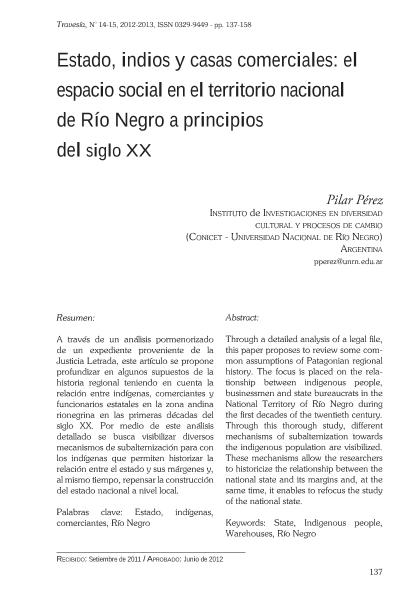Artículo
A través de un análisis pormenorizado de un expediente proveniente de la Justicia Letrada, este artículo se propone profundizar en algunos supuestos de la historia regional, teniendo en cuenta la relación entre indígenas, comerciantes y funcionarios estatales en la zona andina rionegrina en las primeras décadas del siglo XX. Por medio de este análisis detallado se busca visibilizar diversos mecanismos de subalternización para con los indígenas que permiten historizar la relación entre el estado y sus márgenes y, al mismo tiempo, repensar la construcción del estado nacional a nivel local. Through a detailed analysis of a legal file, this paper proposes to review some common assumptions of Patagonian regional history. The focus is placed on the relationship between indigenous people, businessmen and state bureaucrats in the National Territory of Río Negro during the first decades of the twentieth century. Through this thorough study, different mechanisms of subalternization towards the indigenous population are visibilized. These mechanisms allow the researchers to historicize the relationship between the national state and its margins and, at the same time, it enables to refocus the study of the national state.
Estado, indios y casas comerciales: el espacio social en el territorio nacional de Río Negro a principios del siglo XIX
Fecha de publicación:
06/2012
Editorial:
Instituto de estudios socio-económicos
Revista:
Travesía
ISSN:
0329-9449
e-ISSN:
2314-2707
Idioma:
Español
Tipo de recurso:
Artículo publicado
Clasificación temática:
Resumen
Palabras clave:
Estado
,
Indígenas
,
Comerciantes
,
Río Negro
Archivos asociados
Licencia
Identificadores
Colecciones
Articulos(IIDYPCA)
Articulos de INST. DE INVESTIGACIONES EN DIVERSIDAD CULTURAL Y PROCESOS DE CAMBIO
Articulos de INST. DE INVESTIGACIONES EN DIVERSIDAD CULTURAL Y PROCESOS DE CAMBIO
Citación
Pérez, Pilar María Victoria; Estado, indios y casas comerciales: el espacio social en el territorio nacional de Río Negro a principios del siglo XIX; Instituto de estudios socio-económicos; Travesía; 14-15; 6-2012; 137-158
Compartir




